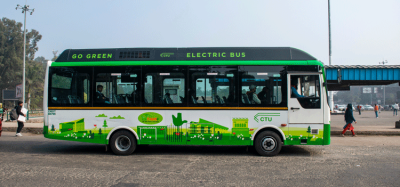New ‘hyperlocal’ sensor network will monitor London’s air quality
- Like
- Digg
- Del
- Tumblr
- VKontakte
- Buffer
- Love This
- Odnoklassniki
- Meneame
- Blogger
- Amazon
- Yahoo Mail
- Gmail
- AOL
- Newsvine
- HackerNews
- Evernote
- MySpace
- Mail.ru
- Viadeo
- Line
- Comments
- Yummly
- SMS
- Viber
- Telegram
- Subscribe
- Skype
- Facebook Messenger
- Kakao
- LiveJournal
- Yammer
- Edgar
- Fintel
- Mix
- Instapaper
- Copy Link
Posted: 22 June 2018 | Intelligent Transport | No comments yet
The new street-by-street monitoring project is the result of a partnership between the Greater London Authority and C40 Cities…


The Mayor of London Sadiq Khan and C40 – a network of cities committed to implementing bold action on climate change – have launched a new project to better understand Londoners’ exposure to air pollution across the city.
Sensors are to be installed to measure harmful pollution in tens of thousands of locations, drastically improving London’s air quality monitoring network.
Air pollution is threatening the health of Londoners, with most areas of the capital regularly breaking limits for safe levels of air pollution. Scientists at King’s College London stated that thousands of Londoners’ lives each year end sooner than they should because of unclean air. The yearly cost of dirty air to London’s economy was estimated to be £3.7 billion.
London already has a high quality network of air quality monitors. Despite this, the network does not cover enough of the city. More sensors and more data are needed to determine which actions tackling air pollution are best. More sensors will help explain how air quality changes not just because of the amount of traffic, but also because of other factors such as weather and road layout.
The Mayor of London and C40 Vice Chair, Sadiq Khan, said: “London’s toxic air is leading to the premature deaths of thousands of Londoners every year so I am pleased that we are embracing the very latest smart technology to monitor hot-spots and demonstrate how effective our policies to combat this global issue are. I’m doing everything in my power to tackle London’s lethal air including cleaning up our bus and taxi fleets, introducing the Toxicity Charge for the oldest polluting vehicles in central London and bringing forward the introduction of the world’s first Ultra-Low Emission Zone to start in April 2019.
From July 2018, new fixed and mobile sensors will be rolled out across London’s streets. In the worst affected areas and sensitive locations, 100 fixed sensors will be fitted to lampposts and buildings and two dedicated Google Street View cars will be driving across the city, mapping air pollution in great detail. The two cars assigned to this project will take air quality readings every 30m, creating a picture over the course of a year and identifying pollution ‘hotspots’ that the existing network of monitors might miss.
With this new ‘hyperlocal’ data, the Mayor will be able to track what actions are making the biggest difference to people’s health.
“This project will provide a step change in data collection and analysis that will enable London to evaluate the impact of both air quality and climate change policies and develop responsive interventions,” said Executive Director for Environmental Defense Fund Europe, Baroness Bryony Worthington. “A clear output of the project will be a revolutionary air monitoring model and intervention approach that can be replicated cost-effectively across other UK cities and globally, with a focus on C40 cities.”
Online maps showing data in real time will give Londoners information on how dirty the air is as they move around the city. These new tools will help the capital take action to tackle the most dangerous environmental threat to people’s health. The study will improve the accuracy of air pollution forecasts for the coming three days, making it possible for people to plan and respond to high pollution warnings.
The results will be shared with the 96 members of the C40 Cities network, with the ambition of improving air quality for hundreds of millions of people living in cities around the world.
Mark Watts, C40, Executive Director said: “Almost every major city in the world is dealing with the threat of toxic air pollution, which is taking an incredible toll on the health of citizens, public finances, quality of life and contributing to climate change. London is already a world leader in responding to this global threat and with this initiative it will set a new global standard for how street level air quality monitoring can inform strategic policy making. Cities across the C40 network and around the world will be watching closely to understand how this street level air quality monitoring can deliver cleaner air for their citizens.”
Related topics
Air Quality
Related cities
London, United Kingdom
Related organisations
C40 Cities
Related people
Bryony Worthington, Mark Watts, Sadiq Khan








